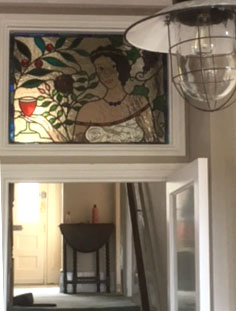I made this front door panel back in 2011 but recent building works led to the door being slammed and various cracks (marked with red dots) occurred. Shaped cracks can be tricky to replace on site and with some particularly complicated shapes this panel needed to be removed and worked on flat on the bench.
Identify which shapes need replacing - repairs can be expensive and if just a tail end is broken it may be fine with a bridge of lead (or strap) across. This piece has a crows foot crack and the lead would need to be too wide visually to cover it. First tallow your joints.
Remove the existing solder with a hot iron - preferably gas, brushing the joints with a close haired nylon brush.
Removing the solder allows you to cut the joints with a sharp knife which will allow you to lift the leaf of the lead more fully. Remove the cement with a sharp pick - a dental pick is good!
Brush some oil onto the leads with light engine oil or similar. This is not so useful for newer leads but for older more brittle leads it helps to make them more malleable.
Lift up the leaf of the lead (on the cracked pane side) with an oyster knife using the existing glass as leverage.
Use the outline of the upturned leaf to mark your new piece. It's best to make the mark just short of the edge of the leaf, that way you cut the glass a bit smaller and you do not have to do a lot of grozing. Though the panel was not made that long ago the new stock of the background glass has changed a lot being much less seedy and clearer. Luckily I had just enough old stock to cover the more damaged pieces.
Cut away the old glass, scoring the cracked pane and tapping out gently.
Drop the new piece in.
Flatten the leads with a Fid or Larikin. Wire brush. Resolder joints.
Tape the piece in place so that it is centred and any gaps are covered. Where there are multiple replacements recementing is best to reseal the whole panel and make it watertight.
Panel cemented and polished before refitting. Because an important feature of this panel is its being symmetrical with the matching opposite piece having a single line crack (and to reduce costs in taking the single line cracked piece out) it was necessary to strap the unbroken piece. Other small straps were added to 'tail end' pieces that were broken and the other more noticeable cracks replaced.
















































